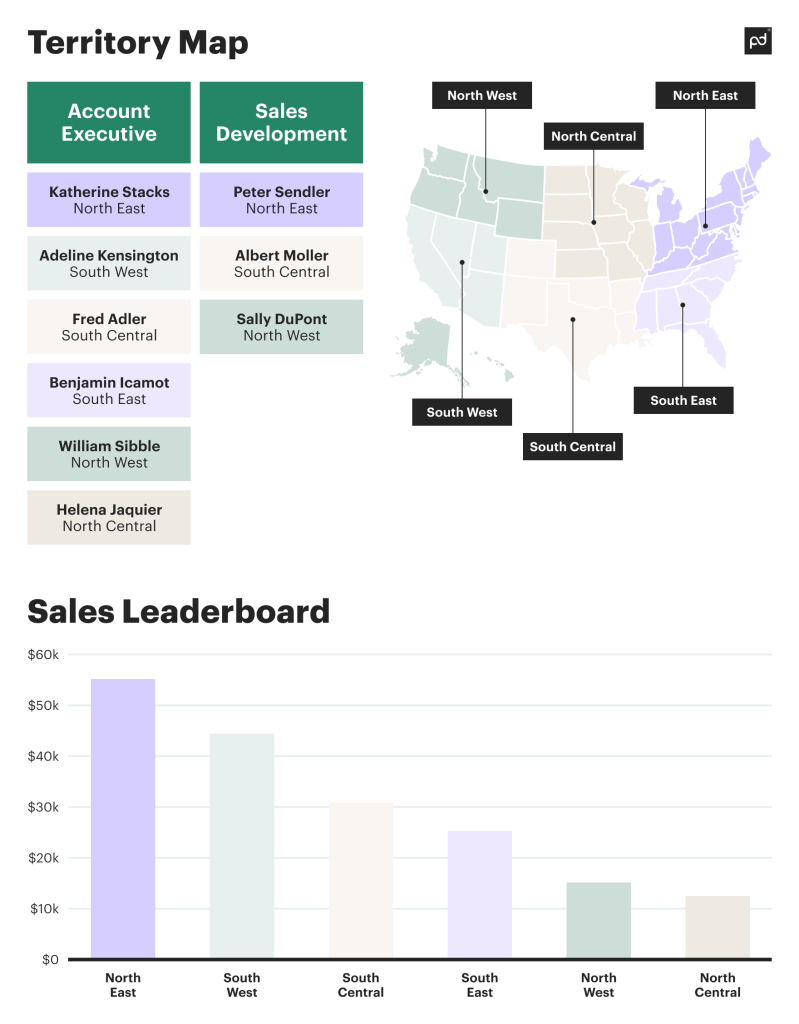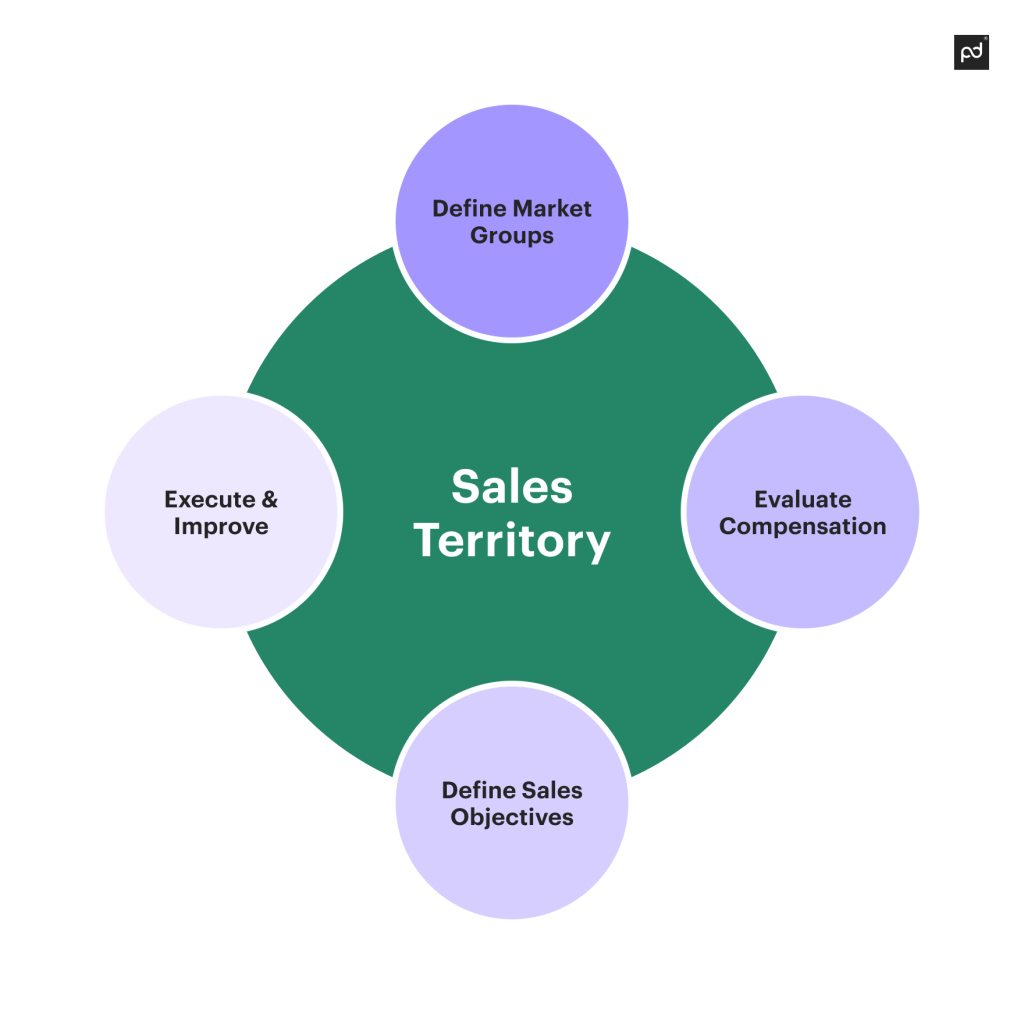Effective sales territory management is key to maximizing revenue and ensuring that your sales team operates efficiently.
But what does it entail, and how can you optimize it?
Key takeaways
- Historical data can be leveraged to determine new market potential and which areas are the most cost effective in terms of travel for sales teams, when needed.
- Thoroughly researching new areas and understanding their laws and regulations will help you successfully break into new territories.
- Well-balanced sales territories helps your employees to manage their workload and maximize on sales potential.
- By tracking KPIs and sales revenue, you can appropriately adjust territories in evolving markets for higher customer acquisition and retention rates.
What is sales territory?
A sales territory is a specific area that is assigned to a single salesperson or more likely, an entire sales team.
When your company is large enough, it might make sense to start dividing your sales by territory and/or region and break into different territories over time.
This will include new sales goals specific to the geographic location. The goal is to increase profitability by finding new leads.
To get to this point, and to successfully carry it out, you need a sales territory plan.
Breaking into and assigning the correct people to new sales territories involves an undertaking of market research and sales strategy.
This includes regulations, language and cultural barriers and differences with customer relationships and sales process, discovering the new leads, new territory pain points and how to best address them, and more.
Document Tracking analytics can increase your close rate by up to 36%.
With real-time notifications connected to your slack and e-mail, you can quickly assess whose viewed or signed a proposal.
These analytics also give you insight to how long people spend on documents, helping you determine which areas may need work by tracking the completion rate.
Benefits of sales territory management
To keep all of this information and planning efficient, a manager or sales leader is typically in charge of each sales territory.
This person will oversee the team, the region, and the overall performance of the cities, regions, or countries included in that territory.
Sales territory mapping is the first step in the process.
Companies will typically utilize demographic information to plan and analyze specific locations within the region to target and the best approach for their sales territory management plan.

Having your specific territories mapped out will allow you to oversee more clear data and follow territory trends.
In the image above, the U.S. is divided into six separate regions, split by two teams (Account Executive and Sales Development) and then listed per salesperson revenue.
This is just one example of how you can organize your sales mapping.
Our software integrates seamlessly with your RevOps tools such as Salesforce, Chilipiper, Pipedrive, and more to make the sales mapping process easy.
Depending on your industry, you may choose to divide up territories by product.
For example, perhaps you offer food and beverage as well as health products.
Food and beverage may do well in territory A, whereas health products may perform better in territory B.
Keeping a pulse on the analytics of each target market and the target customer will help you to determine which territory assignments more worth your time and how big of a sales team is needed.
We have a library of over 1,000 free business documents.
You can speed up the process to close sales quicker by picking one of our pre-made templates.
When you’re ready to make the sale, our Deal Rooms feature helps you organize and share all your essential sales information.
Collaboration is easy with the shared space, allowing multiple parties to access the same information.
For instance, you may have your sales teams divided by region, but may also need them to have visibility into all regions.
Tracking your entire sales cycle in one easy place streamlines the quote to close process, no matter where your team is.
How to set up sales territories
Breaking into and establishing new sales territories doesn’t have to be overwhelming. We’ve done the work and broken down the steps for you.
1. Determine new territories
Figure out what area(s) your company considers to be untapped markets.
This could be as small as one city, or as big as a whole country. It will depend on your company’s objectives and current presence.
2. Research
Once you have some new territories in mind, it’s time to do some research.
Create a customer profile of your ideal client, what language they speak, their culture, where they work, their pain points, and roughly how much of the market the comprise.
This customer base can be comprised of customer data from sales representatives.
Once you know your customer needs, you can better determine your sales strategy and revenue forecasting.
3. Analyze
Look into the buying cycles, pricing, products, conversions and more of the area.
Understand the regulations and laws in the area so you are familiar with the legal implications.
If you’re looking to break into an EU country, refer to the GDPR compliance laws.
4. Sales plan
To set up your sales plan, determine your revenue goals, timeline, prospects and their locations, and your sales reps past data.
This will help you to estimate numbers and leads to generate monthly goals.
5. Assign territories
Once you have all your sales data, you can determine which people and teams go best with the new territories and their potential customers.
This could be in-person, remote, or a combination of the two.
Whichever approach makes the most sense depending on your company size, the geographical area, and your sales targets.

Unlock the potential of your sales territories
With integrations to CRMs through Zapier, linking your tools through PandaDoc is intuitive and easy.
Whether you’re using Deal Rooms to grant multiple teams access to analytics, quotes, and revenue metrics, or you need some help with proposals, we’ve got you covered.
Remember that it takes time to determine best methods when breaking into a new sales territory, whether it’s a town or a country.
PandaDoc gives you a look into data-driven results within customer segments, so you can tweak your approach as needed for improved sales performance.
With the help of PandaDoc, a solid sales team and the right processes in place, you can start to successfully add new territories to your sales pipeline.
Disclaimer
Parties other than PandaDoc may provide products, services, recommendations, or views on PandaDoc’s site (“Third Party Materials”). PandaDoc is not responsible for examining or evaluating such Third Party Materials and does not provide any warranties relating to the Third Party Materials.


